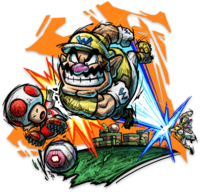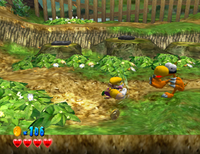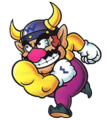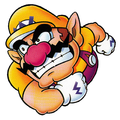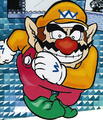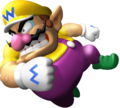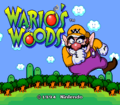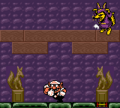Dash Attack
- “With my 'body slam', I'm not afraid of pirates.”
- —Wario, Wario Land: Super Mario Land 3 instruction booklet, page 4.
The Dash Attack,[1][2] also known as Body Slam,[3][4] Barge,[5] Wario Attack,[6] Dashing,[7] Attack,[8][9][10] and Shoulder Barge,[11] is one of Wario's signature attacks. It consists of him charging at high speed while ramming everything on his path using his powerful shoulders. The move first appeared in Wario Land: Super Mario Land 3, and has most prominently appeared in the Wario Land series. The main purpose of the attack is damaging enemies, but it can also hit switches or break open treasure chests and blocks.
Roy Koopa is shown to perform a similar attack in his sprites for Super Princess Peach as well as in New Super Mario Bros. 2. In Yoshi's Island DS, Baby Donkey Kong likewise performs a similar move.
History
Wario Land series
This move is a simple attack in the Wario Land games; it can be used to attack one enemy at a time or to destroy blocks, and normally allows Wario to move faster than running. Jumping in the middle of this attack changes it into a Jump Attack,[12] which ends upon landing or turning around. The cave master from Wario Land II makes use of a similar attack when he is confronted by Wario in order to knock him out of the arena, forcing Wario to restart the battle; in turn, Wario must attack the cave master the same way three times to claim victory. In Wario Land 3, it can be upgraded to break harder blocks and attack several enemies at once. Wario Land 4 was the first game to introduce the name "Dash Attack" (and subsequently its aerial variant Jumping Dash Attack),[13] however, unlike its contemporary usage, this term was used to describe a more powerful variant of the same ability where Wario quickly rushes as his speed greatly increases; then, he is able to run into multiple blocks and enemies without stopping. He is also able to break the more solid, blue blocks. His regular attack is also present, but compared to this "Dash Attack", it is less powerful and Wario bounces back against blocks. To avoid future confusion in later games, the name Dash Attack was given to Wario's regular attack, with the original "Dash Attack" move getting removed, but also giving Wario different alternatives to perform similar moves like the Max Fastosity Dasherators seen in Wario Land: Shake It!.
Wario's Woods
In Wario's Woods, when Toad takes time in a round, Wario will temporarily take the place of Birdo and perform an attack periodically, knocking the ceiling a step downwards.
Wario World
In Wario World, the Dash Attack makes Wario take off in a burst of speed when the player presses the ![]() Button. This is handy for quickly moving around or barreling through enemies. Another move, coupling a Dash Attack with a punch, can be executed by pressing, holding, and releasing the
Button. This is handy for quickly moving around or barreling through enemies. Another move, coupling a Dash Attack with a punch, can be executed by pressing, holding, and releasing the ![]() Button.
Button.
WarioWare series
In the WarioWare games, the Dash Attack appears in a few microgames referencing the Wario Land games, for example, in Loot Scoot, it enables Wario to break through walls and repel mummies to escape an avalanche of gold and treasure; another example is found in a microgame simply titled Wario Land (specifically based on Wario Land 4) where Wario must use the Dash Attack to successfully take out a Spear-Mask while avoiding its front spear. In WarioWare: Get It Together!, the Dash Attack is Wario's main gameplay mechanic. Performed by pressing , it can be used in microgames to push and break objects.
Wario: Master of Disguise
In Wario: Master of Disguise, Thief Wario can use a short-ranged Dash Attack. Unlike in past platformers featuring the move, Wario immediately returns in place after executing it.
Super Smash Bros. series
In the Super Smash Bros. series, the Dash Attack appears as Wario's forward smash attack in Super Smash Bros. Brawl, and like in Wario: Master of Disguise, Wario stays in one spot while executing it, unless he is in his Wario-Man form. The move returns in Super Smash Bros. Ultimate, which calls it Shoulder Tackle in the tips, but was aptly made his dash attack; for this game, the move behaves more similarly to the Dash Attack from the Wario Land games, covering a longer distance.
Mario Strikers: Battle League
A Dash Attack is used by Wario in Mario Strikers: Battle League as he tackles.
Gallery
Artwork
Wario Land II
(Nintendo Magazine System)
Screenshots
Wario using the attack in Wario's Woods title screen
Wario knocking the cave master in Wario Land II
Wario attacking during Wolfenboss' battle in Wario Land 3
The original "Dash Attack", seen in Wario Land 4
The Dash Attack Wario uses as a forward smash in Super Smash Bros. Brawl.
The Dash Attack utilizes its more traditional properties during Wario's Final Smash.
Wario attacking a Volcannon in Wario Land: Shake It!
Wario's Dash Attack in Super Smash Bros. Ultimate
Sprites
Wario Land: Super Mario Land 3
(Jet Wario)Virtual Boy Wario Land
(Bull Wario)
Names in other languages
Dash Attack
| Language | Name | Meaning | Notes |
|---|---|---|---|
| Japanese | 体当たり攻撃[14] (Wario Land: Super Mario Land 3) Taiatari Kōgeki |
Tackle Attack | |
| 体当たり[15] (Virtual Boy Wario Land) Taiatari |
Tackle | ||
| アタック[16][17] (Wario Land II / Wario Land 3 / Wario Land 4) Atakku |
Attack | ||
| ダッシュアタック[17][18] (Wario Land 4 / Wario World / Wario Land Shake) Dasshu Atakku |
Dash Attack | ||
| ダッシュ (Wario World)[?] Dasshu |
Dash | ||
| ショルダータックル (Wario: Master of Disguise)[?] Shorudā Takkuru |
Shoulder Tackle | ||
| French | Attaque smash (Wario Land 3)[?] | Smash attack | |
| German | Rippentriller (Wario Land: Super Mario Land 3)[?] | Rib Trill, possibly a pun on Lippentriller ("lip trill"), a type of trill performed on brass instruments | |
| Italian | Schiacciata a terra (Wario Land: Super Mario Land 3)[19] | Ground slam | |
| Attacco[20][21] | Attack | ||
| Attacco fulmineo [22][23] | Rapid attack | ||
| Spanish | Empellón (Wario Land: Super Mario Land 3)[?] | Shove | |
| Ataque relámpago (Dash Attack variant, Wario Land 4)[?] | Lightning attack | ||
| Ataque raudo (Wario Land: Shake It!)[?] | Swift attack |
Jump Attack
| Language | Name | Meaning | Notes |
|---|---|---|---|
| Japanese | ジャンピングアタック[24][25] Janpingu Atakku |
Jumping Attack | |
| ジャンピングダッシュアタック[26] (Wario Land 4) Janpingu Dasshu Atakku |
Jumping Dash Attack | ||
| Italian | Attacco salto[27] | Jump attack |
References
- ^ Nintendo (2003). Wario World instruction booklet. Nintendo of Europe (British English). Page 7-8.
- ^ Nintendo (2003). Wario World instruction booklet. Nintendo of America (American English). Page 9-10.
- ^ Nintendo (1994). Wario Land: Super Mario Land 3 instruction booklet. Nintendo of America (American English). Page 11.
- ^ Hamm & Rudolf GmbH, Frankfurt (1994). Super Game Boy Player's Guide. Nintendo of America (American English). Page 27.
- ^ Nintendo. Virtual Boy Wario Land instruction booklet. Nintendo of America (American English). Page 22.
- ^ In-game information for the Loot Scoot microgame in WarioWare, Inc.: Mega Microgame$! and WarioWare Gold
- ^ Stratton, Steve (September 22, 2008). Wario Land: Shake It! PRIMA Official Strategy Guide. Prima Games (American English). ISBN 978-0-7615-6113-2. Page 4.
- ^ Nintendo (1998). Wario Land II instruction booklet. Nintendo of America (American English). Page 5.
- ^ Nintendo (2000). Wario Land 3 instruction booklet. Nintendo of America (American English). Page 5.
- ^ Nintendo (2001). Wario Land 4 instruction booklet. Nintendo of America (American English). Page 7.
- ^ July 1994. Nintendo Magazine System (AU) issue 16. Page 18.
- ^ Nintendo (2001). Wario Land 4 instruction booklet. Nintendo of America (American English). Page 9.
- ^ Nintendo (2001). Wario Land 4 instruction booklet. Nintendo of America (American English). Page 10.
- ^ Nintendo (1994). Super Mario Land 3: Wario Land instruction booklet. Nintendo (Japanese). Page 3.
- ^ Nintendo (1995). Virtual Boy Wario Land: Awazon no Hihō instruction booklet. Nintendo (Japanese). Page 18.
- ^ Nintendo (2000). Wario Land 3: Fushigi na Orgel instruction booklet. Nintendo (Japanese). Page 5.
- ^ a b Nintendo (2001). Wario Land Advance: Yōki no Otakara instruction booklet. Nintendo (Japanese). Page 7 and 10.
- ^ Nintendo (2008). Wario Land Shake instruction booklet. Nintendo (Japanese). Page 19, 24, and 25.
- ^ Nintendo (1994). Wario Land: Super Mario Land 3 European booklet. Nintendo of Europe (Italian). Page 105.
- ^ Nintendo (1999). Wario Land II European manual. Nintendo of Europe (Italian). Page 105.
- ^ Nintendo (2001). Wario Land 4 European manual. Nintendo of Europe (Italian). Page 105.
- ^ Nintendo (2003). Wario World Italian manual. Nintendo (Italian). Page 7.
- ^ Nintendo (2008). Wario Land: The Shake Dimension Italian manual. Nintendo (Italian). Page 8.
- ^ Nintendo (2000). Wario Land 3: Fushigi na Orgel instruction booklet. Nintendo (Japanese). Page 6.
- ^ Nintendo (2001). Wario Land Advance: Yōki no Otakara instruction booklet. Nintendo (Japanese). Page 9.
- ^ Nintendo (2001). Wario Land Advance: Yōki no Otakara instruction booklet. Nintendo (Japanese). Page 10.
- ^ Nintendo (2001). Wario Land 4 European manual. Nintendo of Europe (Italian). Page 107.
| Wario Land: Super Mario Land 3 | |||
|---|---|---|---|
| Characters | Wario • Brown Sugar Pirates • Mario | ||
| Bosses | Spiked Koopa • Minotaur • Penguin • Devil's Head • Bobo • Ghost • Captain Syrup • Genie | ||
| Worlds | Rice Beach • Mt. Teapot • Sherbet Land • Stove Canyon • SS Tea Cup • Parsley Woods • Syrup Castle | ||
| Power-ups | Bull Pot • Dragon Pot • Garlic Pot • Jet Pot • Star | ||
| Collectibles | ? Block • 1 Gold Coin • 10 Gold Coin • 100 Coin • 3-Up Heart • Heart • Key • Treasure | ||
| Enemies and obstacles | Batto Shuruken • Bee Fly • Big • Bō • Bucket Head • Chicken Duck • D.D. • Demon Bat • Dropper • Floater • Gaugau • Goboten • Guragura • Harisu • Helmut • Knight • Konotako • Kōmori Missile • Lance • Maizō • Mine • Muncher • Paidan • Pecan • Penkoon • Pikkarikun • Pinwheel • Piranha Plant • Pirate Goom • Pouncer • Skewer • Sparky • Spiked ball • Togemaru • Ukiwani • Wanderin' Goom • Watch • White puff • Yadorā • Yarikuri Obake | ||
| Miscellaneous | Gallery • Glitches • Media • Pre-release and unused content • Staff | ||
| Wario Land II | |
|---|---|
| Main characters | Wario • Captain Syrup |
| Supporters | Gull • Hen • Owl • Turtle |
| Bosses | Awabō • Big Kamukamu • Bobo • Cave master • Dunk • Ghost • Giant bee • Giant snake • Giant spear man • Mecha Kuri |
| Chapters | Chapter 1 • Chapter 2 • Chapter 2* • Chapter 2** • Chapter 3 • Chapter 3* • Chapter 4 • Final Chapter • Final Chapter* • Final Chapter** • The Really Final Chapter |
| Conditions | Ball • Bouncy Wario • Bubble Wario • Crazy Wario • Fat Wario • Flat Wario • Frozen Wario • Hot Wario • Puffy Wario • Tiny Wario • Zombie Wario |
| Enemies | Bee • Bird • Chūta • Cook • D-Bat • D.D. • Drill • Flame • Gaugau • Ghost • Grunt • Gugi • Inamazu • Kamukamu • Pecan • Penguin • Pirate Goom • Pogo Guy • Punch • Rooster • Tobī • Togemen • Tsuriuo • Utsutsubo • Weight • White puff • Wizard • Yukimaru • Zombie |
| Objects | 10 Gold Coin • 100 Coin • Alarm clock • Big Block • Bonfire Block • Brick • Coin • Doughnut block • Enemy Block • Ice block • Kotsuheri • Lance • Spike • Stove • Switch |
